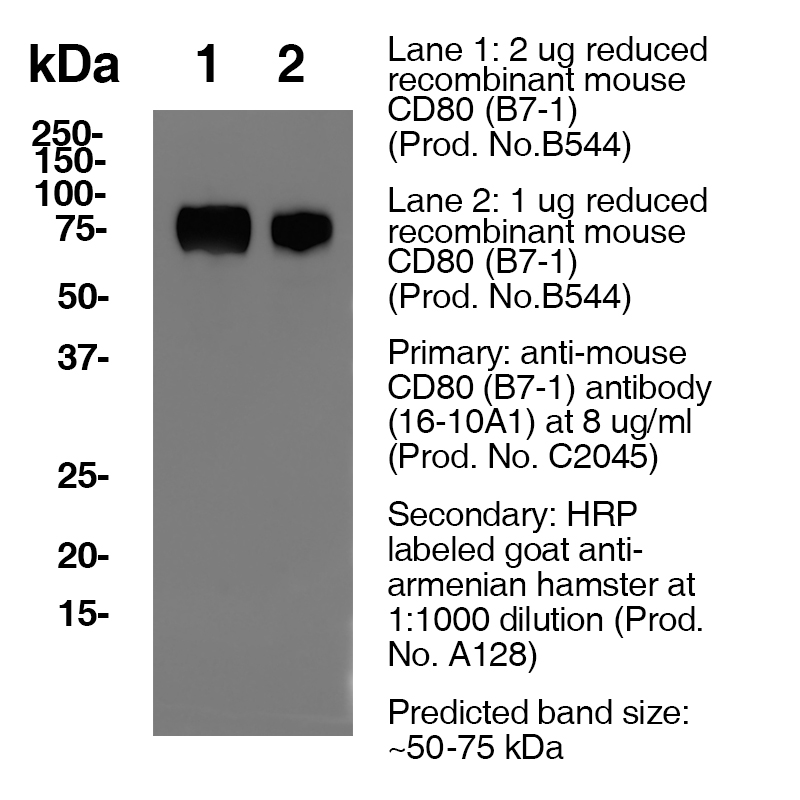Anti-Mouse CD80 [Clone 16-10A1] — Purified in vivo PLATINUM™ Functional Grade
Anti-Mouse CD80 [Clone 16-10A1] — Purified in vivo PLATINUM™ Functional Grade
Product No.: C2390
Clone 16-10A1 Target B7-1 Formats AvailableView All Product Type Monoclonal Antibody Alternate Names B7-1, B71, Ly53, TSA1, Cd28l, Ly-53, MIC17 Isotype IgG Applications B , CyTOF® , in vivo , IP , WB |
Data
Antibody DetailsProduct DetailsReactive Species Mouse Host Species Armenian Hamster Recommended Isotype Controls Recommended Dilution Buffer Immunogen Purified Recombinant Mouse CD80 (>98%) Product Concentration ≥ 5.0 mg/ml Endotoxin Level <0.5 EU/mg as determined by the LAL method Purity ≥98% monomer by analytical SEC ⋅ >95% by SDS Page Formulation This monoclonal antibody is aseptically packaged and formulated in 0.01 M phosphate buffered saline (150 mM NaCl) PBS pH 7.2 - 7.4 with no carrier protein, potassium, calcium or preservatives added. Due to inherent biochemical properties of antibodies, certain products may be prone to precipitation over time. Precipitation may be removed by aseptic centrifugation and/or filtration. Product Preparation Functional grade preclinical antibodies are manufactured in an animal free facility using in vitro cell culture techniques and are purified by a multi-step process including the use of protein A or G to assure extremely low levels of endotoxins, leachable protein A or aggregates. Pathogen Testing To protect mouse colonies from infection by pathogens and to assure that experimental preclinical data is not affected by such pathogens, all of Leinco’s Purified Functional PLATINUM™ antibodies are tested and guaranteed to be negative for all pathogens in the IDEXX IMPACT I Mouse Profile. Storage and Handling Functional grade preclinical antibodies may be stored sterile as received at 2-8°C for up to one month. For longer term storage, aseptically aliquot in working volumes without diluting and store at ≤ -70°C. Avoid Repeated Freeze Thaw Cycles. Country of Origin USA Shipping Next Day 2-8°C RRIDAB_2829485 Applications and Recommended Usage? Quality Tested by Leinco WB Additional Applications Reported In Literature ? CyTOF® B IP Each investigator should determine their own optimal working dilution for specific applications. See directions on lot specific datasheets, as information may periodically change. DescriptionDescriptionSpecificity Clone 16-10A1 recognizes an epitope on mouse CD80. Background CD80 is a highly glycosylated 60 kD protein that is part of the Ig superfamily and is significantly involved in immune cell activation in response to pathogens. CD80 is closely related to, and works in tandem with CD86 (B7-2) to prime T- cells. CD80 binds to CTLA-4 to deliver an inhibitory signal to T cells. The ligation of CD28 on T cells with CD80 and CD86 on APCs co-stimulates T cells resulting in enhanced cell activation, proliferation, and cytokine production. It is thought that CD80 interacts with a ligand on Natural Killer cells, activating the Natural Killer cell-mediated cell death of the CD80 carrier. The activation of Natural Killer cell-mediated death via CD80 interactions has potential as a possible cancer immunotherapy through the induction of CD80 expression on tumor cells. Antigen Distribution CD80 is expressed on activated B cells, monocytes/macrophages, and dendritic cells. Ligand/Receptor CD28 (stimulatory), CD152(CTLA4) (inhibitory) Function T cell costimulation PubMed NCBI Gene Bank ID UniProt.org Research Area Cell Biology . Costimulatory Molecules . Immunology . Neuroscience . Neuroscience Cell Markers Leinco Antibody AdvisorPowered by AI: AI is experimental and still learning how to provide the best assistance. It may occasionally generate incorrect or incomplete responses. Please do not rely solely on its recommendations when making purchasing decisions or designing experiments. Clone 16-10A1 is predominantly used in vivo in mice to block the function of CD80 (B7-1), thereby modulating T cell costimulatory signals essential for immune activation, tolerance, transplant rejection, and cancer immunotherapy.
Other notable in vivo uses include:
Key application details:
Summary Table: Common In Vivo Applications of Clone 16-10A1
Caveats:
Alternative meanings: Commonly used antibodies and proteins with 16-10A1 (anti-mouse CD80) in the literature include:
Summary Table: Common Antibodies/Proteins Used with 16-10A1
In murine immunology literature, when 16-10A1 is used for blocking, phenotyping, or functional assays, anti-CD86 (GL-1 clone) is nearly always included in the same panel so researchers can distinguish or compare the roles of these closely related co-stimulatory ligands. When studying T cell activation pathways, antibodies targeting T cell receptors or activation markers are standard additions. These combinations allow researchers to parse the complex interplay of costimulation and inhibition in T cell responses, particularly in studies of immune checkpoints or APC–T cell interactions. Clone 16-10A1 is a widely cited antibody in immunological research due to its specificity for mouse CD80 (B7-1) and its ability to block CD80’s costimulatory function, making it a crucial tool for studying immune modulation, T cell costimulation, and related disease models. Key findings from scientific literature citations of clone 16-10A1 include:
In summary, clone 16-10A1 is recognized for its robust blockade of mouse CD80-mediated costimulation, enabling precise investigation of immune mechanisms in both basic and translational research. Dosing regimens of clone 16-10A1 (anti-mouse CD80) in mouse models most commonly involve intraperitoneal or intravenous injection at doses around 250 μg per mouse every 3 days, notably for post-bone marrow transplant GVHD models. Key context and variability:
Summary Table: Typical in vivo dosing for 16-10A1 in mouse models
Important notes:
In sum, 250 μg every 2–3 days is the standard in vivo starting regimen for clone 16-10A1, with adjustments made empirically depending on the specific experimental mouse model. References & CitationsTechnical ProtocolsCertificate of Analysis |
Related Products
Prod No. | Description |
|---|---|
S211 | |
R1364 | |
I-140 | |
C247 | |
F1175 | |
S225 | |
A132 | |
S571 |
Formats Available
Prod No. | Description |
|---|---|
C2247 | |
C2242 | |
C2243 | |
C2244 | |
C2245 | |
C2246 | |
C2046 | |
C2047 | |
C2048 | |
C2049 | |
C2045 | |
C2044 | |
C2390 |
 Products are for research use only. Not for use in diagnostic or therapeutic procedures.
Products are for research use only. Not for use in diagnostic or therapeutic procedures.



